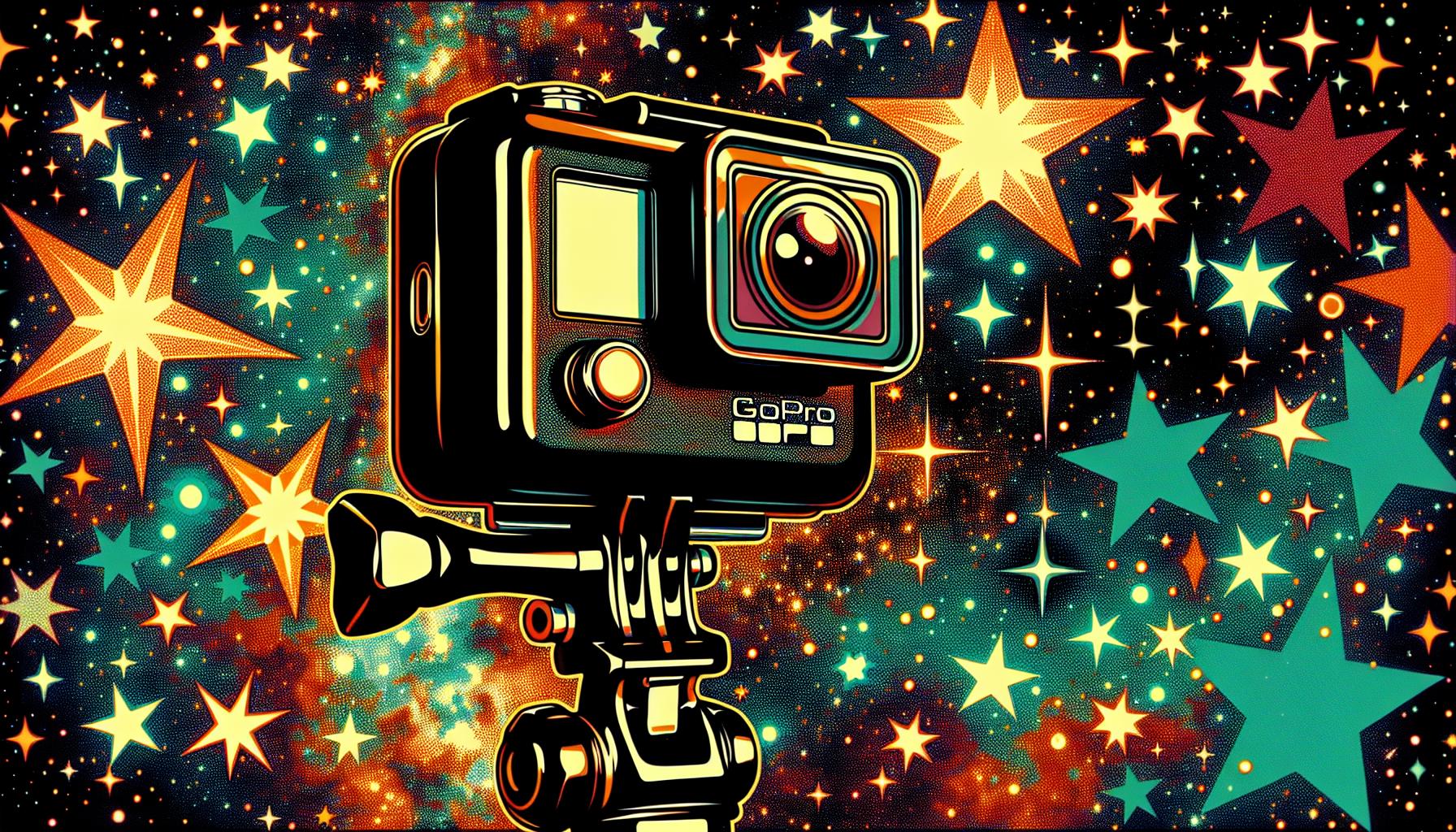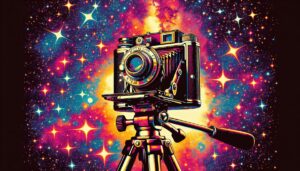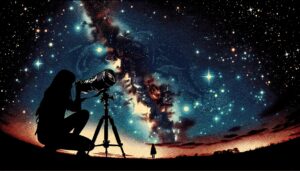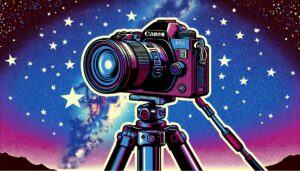This site contains affiliate links to products. I may receive a commission for purchases made through these links.
Astrophotography isn’t just for the pros anymore, and I’m here to tell you why. With a GoPro, anyone can capture the stunning beauty of the cosmos right from their backyard. It’s a game-changer, and I’m excited to share some tips and tricks with you.
You might think you need high-end gear for astrophotography, but that’s not the case. A GoPro, with its wide-angle lens and long-exposure capabilities, can work wonders. It’s all about knowing how to use it.
Why Choose a GoPro for Astrophotography?
Have you ever looked up at the night sky and felt a sense of awe? Well, imagine capturing that feeling in a photograph. Sound challenging? Think again. With a GoPro, astrophotography can be both accessible and profoundly rewarding for anyone.
There’s a common misconception that costlier tools are synonymous with high-resolution astrophotography. But I’m here to debunk that myth. Investing in a GoPro won’t break your bank, yet it’ll fetch you impressive results. One striking feature of the GoPro is its wide-angle lens that enables a broad field view, crucial for capturing expansive celestial bodies.
Let’s not forget about the GoPro’s superior long-exposure capabilities. The long-exposure helps in enhancing image clarity when capturing faint stars, thus enabling you to snap up detailed images of the cosmos that would otherwise stay hidden to the naked eye.
Moreover, a GoPro is designed for its robustness and extreme versatility. Whether you plan on a city rooftop or a wilderness trek, this weather-resistant gadget won’t let you down. Its compact and rugged design makes it a perfect companion for all your stargazing adventures.
And the cherry on top? Its user-friendly interface. The GoPro provides an intuitive and straightforward user experience. So whether you’re a beginner tackling this exciting genre of photography or an experienced shutterbug looking to experiment, you won’t be overwhelmed.
Considering its affordability, high-quality wide-angle lens, long-exposure capabilities, durability, and simplicity, a GoPro is an excellent choice for astrophotography.
Understanding the Basics of Astrophotography
Before we get into the nitty-gritty of using a GoPro for astrophotography, it’s crucial to understand the basics of this fascinating field. Astrophotography is a specialized type of photography that involves capturing images of astronomical objects, celestial events, and areas of the night sky. Unlike common photography genres, astrophotography is a test of skills, patience, and most importantly, your ability to adapt to low-light situations.
The backbone of astrophotography is long-exposure photography. It’s where your camera stays open for longer periods of time to allow more light to enter. This process helps in capturing detailed images of celestial objects like stars and planets, which with the naked eye, are otherwise not always visible in great detail.
Bringing together the technical skill of long-exposure photography with your GoPro’s wide-angle lens and you’ve got a recipe for some truly spectacular shots. These wide-angle shots can really emphasize the grandeur of the night sky, filling the frame with clusters of twinkling stars.
Adaptability in low-light conditions is crucial. In astrophotography, the amount of natural light you have to play with is minimal – after all, we’re shooting in the dark here! Your camera’s ISO performance and ability to minimize noise are key. Thankfully, GoPros have a solid reputation in this regard.
One of the elements that sets astrophotography apart is the need for clear, dark skies with minimal light pollution. Light pollution refers to excessive or intrusive artificial light. Unfortunately, large towns and cities often harbor lots of light pollution which washes out the night sky and makes it harder to get a clear shot.
Above all, remember, astrophotography is part art, part science. It requires patience, practice, and a willingness to learn. Having a GoPro can be a great advantage given its durability, user-friendly interface, and, cost-effectiveness. The journey through this form of photography is surely a rewarding one, right from your very first click.
Essential Equipment and Accessories
If you’re looking to venture into the world of astrophotography, you’ll realize that your GoPro camera, while important, is just a piece of a larger puzzle. There are several other tools and accessories that can significantly enhance your sky gazing and shooting experience. So what are these essential items that you’ll definitely need in your astrophotography kit? Let’s dive in!
Tripod: It tops the list. You really can’t do without a tripod in astrophotography— not if you’re serious about taking sharp, high-quality images. This handy tool provides the stability your GoPro needs to capture clear photos of celestial bodies.
Remote Shutter Release: This device is another must-have. It allows you to take pictures without physically touching your camera. This means no shaking or disturbing the camera during those critical exposure moments.
GoPro’s Night Mode: Well, it’s not exactly an accessory, but it’s an important feature you should know about. Your GoPro’s night mode can help you capture significantly better photos when used in combination with other gear.
Extra Batteries: Don’t let your astrophotography adventure hit a roadblock. Always carry extra batteries with you. Cold temperatures can drain battery life quicker than you think.
Portable Charger: Along with extra batteries, a portable charger ensures that you’re never out of power during your astrophotography outings.
Lens and Sensor Cleaning Kit: You would want your lenses and sensors spotless for the best output. A lens and sensor cleaning kit ensures your GoPro is free from dust, dirt, and smudges.
Setting up Your GoPro for Astrophotography
Astrophotography requires a bit of setup to ensure everything’s in place for those captivating stellar snapshots. Now, let’s dive deep into the specifics of getting your GoPro ready for astrophotography.
Camera Settings
Kick-starting this process is all about getting the settings right. Aim for a high-resolution setting, ensuring your GoPro is primed for capturing the most detail. Typically, 4K resolution will be your best bet.
The GoPro’s ISO should be set high, but not too high that the image results in graininess. Try a range between 800 and 1600 for optimal imaging. Shutter speed can be trickier to manage; however, a good starting point for long exposure astrophotography with your GoPro would usually be at 30 seconds.
One crucial factor not to overlook is the white balance. This will have a significant impact on the coloration of your night sky shots. I’d suggest leaving it on auto unless you have a specific effect you’re after.
GoPro App
Interval shooting is another key aspect to consider, and the GoPro App can aid significantly here. It will help in programming your camera to take continuous shots over some time, perfect for capturing the moving stars. This also prevents drain on your camera storage.
Tripod and Remote Shutter Release
Your trusty tripod and remote shutter release are key accessories to couple with your GoPro. These tools are indispensable for attaining sought-after stability and avoiding unintentional camera shakes during long exposure shots.
Dual Battery System
Investing in a dual-battery system can be a real game-changer. This way, you won’t miss out on photographing those meteor showers when your first battery runs out. Just pop in the second battery and you’re good to go!
Setting up your GoPro for astrophotography may take some tweaking and experimenting with various settings. However, I’m confident that with these tips you’ll be well on your way to capturing truly stunning celestial images. Stick around to read more about special shooting techniques and post-processing tips in the following sections.
Tips and Techniques for Capturing Stunning Astrophotos with a GoPro
Shooting the night sky can be a challenge, but it’s not impossible—especially when you are equipped with a robust device like the GoPro. With the correct settings and techniques, capturing the mesmerizing beauty of the cosmos is just a few clicks away.
When diving into astrophotography with GoPro, the first adjustment you’ll want to make is your GoPro’s resolution. Shoot at the maximum resolution your GoPro allows. This is vital to achieve the fine detail in your celestial snaps that make them stand out.
Your next task is adjusting the ISO level. Setting the ISO between 800 and 1600 is often recommended. This allows enough light to enter the camera without making the image too noisy.
I find it beneficial to use the GoPro App too. The app makes it possible to use interval shooting, programming my GoPro to take a continuous series of shots. This is a game-changer for photographing meteor showers or capturing the rotation of stars.
Stability is key when you’re dealing with long exposures required by night photography. Always use a tripod and consider investing in a remote shutter release. These will help eliminate any camera shake and can spell the difference between a blurred image and a sharp, epic astrophoto.
Lastly, don’t forget to ensure your GoPro’s battery won’t die in the middle of a shoot. Invest in a dual battery system and keep them fully charged.
Remember that astrophotography isn’t purely a science—it’s also an art. There’s no perfectly correct set of settings or equipment. It demands some tweaking and experimentation before you can boat the perfect shot. Whether you’re a beginner or an advanced shooter, everyone gets a unique experience when capturing the cosmos.
Conclusion
So, you’ve got the know-how to capture the cosmos with your GoPro now. Remember, it’s all about fine-tuning those settings. Dial in the right resolution and ISO, and you’re halfway to stellar snaps. Don’t forget the importance of stability – your tripod and remote shutter release are your best friends here. And with the GoPro App, you can set your camera to shoot continuously, capturing every celestial moment.
Power’s key too, so consider a dual battery system to keep your GoPro going. But most importantly, don’t be afraid to experiment. Every star-studded sky offers a new opportunity to perfect your astrophotography skills. Now, go out there and start shooting!




